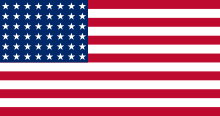United States Army Military Government in Korea
| United States Army Military Government in Korea | ||||||||||
| 재조선 미육군 사령부 군정청 | ||||||||||
| Military occupation / transitional government | ||||||||||
| ||||||||||
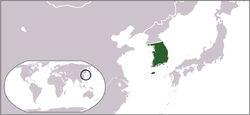 Location of the southern portion of the Korean Peninsula. | ||||||||||
| Capital | Seoul | |||||||||
| Languages | Korean | |||||||||
| Political structure | Military occupation / transitional government | |||||||||
| Military Governor | ||||||||||
| • | Sep 1945 – Dec 1945 | Archibald V. Arnold | ||||||||
| • | Dec 1945 – Sep 1947 | Archer L. Lerch | ||||||||
| • | Oct 1947 – Aug 1948 | William F. Dean | ||||||||
| • | Aug 1948 – Jun 1949 | Charles G. Helmick | ||||||||
| Historical era | Cold War | |||||||||
| • | Surrender of Japan | 15 August 1945 | ||||||||
| • | US troops stationed in South Korea | 8 September 1945 | ||||||||
| • | Autumn Uprising | October 1946 | ||||||||
| • | South Korean general election | 10 May 1948 | ||||||||
| • | Republic of Korea established | 15 August 1948 | ||||||||
| Currency | Won | |||||||||
| ||||||||||
Part of a series on the |
||||||||||||||||||||||||||||||||||||||||||||||||||||||||||||||||||
|---|---|---|---|---|---|---|---|---|---|---|---|---|---|---|---|---|---|---|---|---|---|---|---|---|---|---|---|---|---|---|---|---|---|---|---|---|---|---|---|---|---|---|---|---|---|---|---|---|---|---|---|---|---|---|---|---|---|---|---|---|---|---|---|---|---|---|
| History of South Korea | ||||||||||||||||||||||||||||||||||||||||||||||||||||||||||||||||||
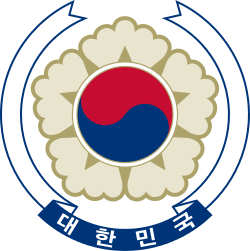 | ||||||||||||||||||||||||||||||||||||||||||||||||||||||||||||||||||
|
||||||||||||||||||||||||||||||||||||||||||||||||||||||||||||||||||
|
| ||||||||||||||||||||||||||||||||||||||||||||||||||||||||||||||||||
The United States Army Military Government in Korea (USAMGIK; Korean: 재조선 미육군 사령부 군정청; Hanja: 在朝鮮美陸軍司令部軍政廳) was the official ruling body of the southern half of the Korean Peninsula from September 8, 1945 to August 15, 1948.
The country in this period was plagued by political and economic chaos, which arose from a variety of causes. The aftereffects of the Japanese occupation were still felt in the occupation zone, as well as in the Soviet zone in the North. Popular discontent stemmed from the U.S. Military Government's support of the Japanese colonial government; then once removed, keeping the former Japanese governors on as advisors; by ignoring, censoring and forcibly disbanding the functional and popular People's Republic of Korea (PRK); and finally by supporting United Nations elections that divided the country.[1]
In addition, the U.S. military was largely unprepared for the challenge of administering the country, arriving with no knowledge of the language or political situation. Thus, many of their policies had unintended destabilizing effects. Waves of refugees from North Korea (estimated at 400,000) and returnees from abroad also helped to keep the country in turmoil.
Background
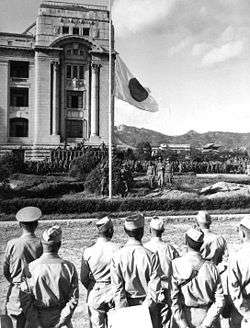
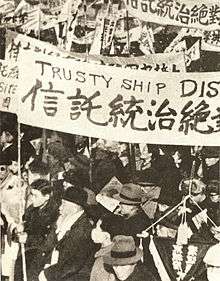
The short-lived People's Republic of Korea had been established in August, in consultation with Japanese authorities, and quickly spread throughout the country. The U.S. Military Government outlawed it in the South shortly after their arrival. The leader of the People's Republic, Yeo Un-hyeong, stepped down and formed the Working People's Party. The U.S. administration also refused to recognize the members of the Provisional Government of the Republic of Korea, led by Kim Ku, who were obliged to enter the country as private citizens.
Key events
After the surrender of the Empire of Japan to the Allies, division at the 38th parallel marked the beginning of Soviet and American command over the North and South, respectively. U.S. forces landed at Incheon on September 8, 1945, and established a military government shortly thereafter. The forces landing at Incheon were of the XXIV Corps of the U.S. Tenth Army. They were commanded by Lt. General John R. Hodge, who then took charge of the government. Four days before he arrived in Korea, Hodge told his officers that Korea "was an enemy of the United States".[2]
On September 9, at a surrender ceremony, Hodge announced that the Japanese colonial government would remain intact, including its personnel and its governor-general. After a major outcry, Hodge replaced the governor-general with an American and removed all the Japanese bureau chiefs, though he, in turn, enlisted the former Japanese bureaucrats as advisors.[3]
Faced with mounting popular discontent, in October 1945 Hodge established the Korean Advisory Council. The majority of the Council seats were given to members of the Korean Democratic Party which had been formed at the encouragement of the U.S. and was primarily made up of large landowners, wealthy businesspeople, and former officials in the colonial government. A few members of the PRK were offered to join, but they refused and instead criticized the Council appointees for their collaboration with the Japanese.[4]
A proposal was made in 1945 for a long-term trusteeship arrangement. In December 1945, the United States and the Soviet Union agreed to administer the country under the U.S.-Soviet Joint Commission, as termed by the Moscow Conference of Foreign Ministers. It was agreed that Korea would govern independently after four years of international oversight. However, both the U.S. and the USSR approved Korean-led governments in their respective halves, each of which was favorable to the occupying power's political ideology. From a number of perspectives, it may be argued that not all Koreans necessarily favoured these arrangements. In the north, Koreans responded with violent insurrections. In the south the interim legislature and the interim government were headed by Kim Kyu-shik and Syngman Rhee, respectively, and the elections for which were met with a large uprising.[5][6]
The USAMGIK tried to contain civil violence in the south by banning strikes on December 8 and outlawing the revolutionary government and the people's committees on December 12. Things spiraled quickly out of control however, with a massive strike on September 23, 1946 by 8,000 railway workers in Busan which quickly spread to other cities in the South. On October 1, police attempts to control rioters in Daegu caused the death of three student demonstrators and injuries to many others, sparking a mass counter-attack killing 38 policemen. In Yeongcheon, a police station came under attack by a 10,000-strong crowd on October 3, killing over 40 policemen and the county chief. Other attacks killed about 20 landlords and pro-Japanese officials. The U.S. administration responded by declaring martial law, firing into crowds of demonstrators and killing a publicly unknown number of people.[7]
Education
Among the earliest edicts promulgated by USAMGIK was one reopening all schools, issued in November 1945. No immediate changes were made in the educational system, which was simply carried over from the Japanese colonial period. In this area, as in others, the military government sought to maintain the forms of the Japanese occupation system.
Although it did not implement sweeping educational reforms, the military government did lay the foundations for reforms which were implemented early in the First Republic. In 1946, a council of about 100 Korean educators was convened to map out the future path of Korean education.
Politics
Although the military government was hostile to leftism from the beginning, it did initially tolerate the activities of left-wing political groups, including the Korean Communist Party. They had attempted to strike a balance between hard-left and hard-right groups, encouraging moderation. However, these overtures frequently had the adverse effect of angering powerful leaders such as Syngman Rhee.
This period of reconciliation did not last long. Within a short time, the military government actively disempowered and eventually banned popular organizations that were gaining support within the general public, including the People's Republic of Korea. The justification given by the USAMGIK was its suspicion that they were aligned with the communist bloc, despite professing a relatively moderate stance compared to the actual Korean Communist Party, which had also been banned at this time.
Inter-Korean relations
At the time of division, the overwhelming majority of Korean industry was concentrated in the North, while most of the agricultural land was in the South. Power lines and shipping connections were maintained during this period, but were frequently and unpredictably cut off. The North, controlled during this period by the Soviet Union, had the ability to wreak havoc in the South by cutting off the supply of electricity or fertilizer, and frequently did so.[8]
Economy
The economy of South Korea did not fare well during this period, although the first foundation-stones of recovery were successfully laid. Serious problems were faced with counterfeiting during this period.
Dissolution
Following the constitutional assembly and presidential elections held in May and July 1948 respectively, the Republic of Korea was officially proclaimed on August 15, 1948. American troops finally withdrew in 1949.
See also
- Operation Blacklist Forty
- History of South Korea
- Korea under Japanese rule
- History of Korea
- Military history of the United States
- List of Korea-related topics
- People's Republic of Korea
- Autumn Uprising of 1946
- Provisional People's Committee for North Korea
- Soviet Civil Authority - Soviet counterpart in North Korea
Notes
- ^ Allan R. Millet, The War for Korea: 1945-1950 (2005) P. 59
- ^ Lee (1984, p. 374); Cumings (1997, p. 189).
- ^ Cumings, 1997, p. 189. Nahm (1996, p. 340) gives "Eighth Army", reflecting the Corps' later affiliation.
- ^ Nahm, Cumings, loc. cit.
- ^ Nahm (1996, p. 351); Lee (1984, p. 375).
- ^ Nahm (1996, p. 340).
- ^ Lee (1984, p. 375).
- ^ Nahm (1996, pp. 330–332); Lee (1984, p. 374).
- ^ Nahm (1996, p. 340).
- ^ Nahm (1996, p. 340).
References
- ↑ Hart-Landsberg, Martin (1998). Korea: Division, Reunification, & U.S. Foreign Policy. Monthly Review Press. pp. 63–67, 70–77.
- ↑ Cumings, Bruce (1981). The Origins of the Korean War, Liberation and the Emergence of Separate Regimes, 1945-1947. Princeton University Press. p. 126.
- ↑ Hart-Landsberg, Martin (1998). Korea: Division, Reunification, & U.S. Foreign Policy. Monthly Review Press. pp. 71–72.
- ↑ Hart-Landsberg, Martin (1998). Korea: Division, Reunification, & U.S. Foreign Policy. Monthly Review Press. pp. 72–73.
- ↑ Hart-Landsberg, Martin (1998). Korea: Division, Reunification, & U.S. Foreign Policy. Monthly Review Press. pp. 75–77.
- ↑ Cumings, Bruce (1981). "The Autumn Uprising". The Origins of the Korean War, Liberation and the Emergence of Separate Regimes, 1945-1947. Princeton University Press.
- ↑ Green Left - Features: HISTORICAL FEATURE: The Korean War - a war of counter-revolution
- ↑ Department of State Publication 3305, October 1948, pg. 25
External links
- Unofficial list of US National Archives documents concerning USAMGIK
- Paramilitary politics under the USAMGIK and the establishment of the ROK, Kim Bong-jin, Korea Journal 43 (2), p. 289-322 (2003).
